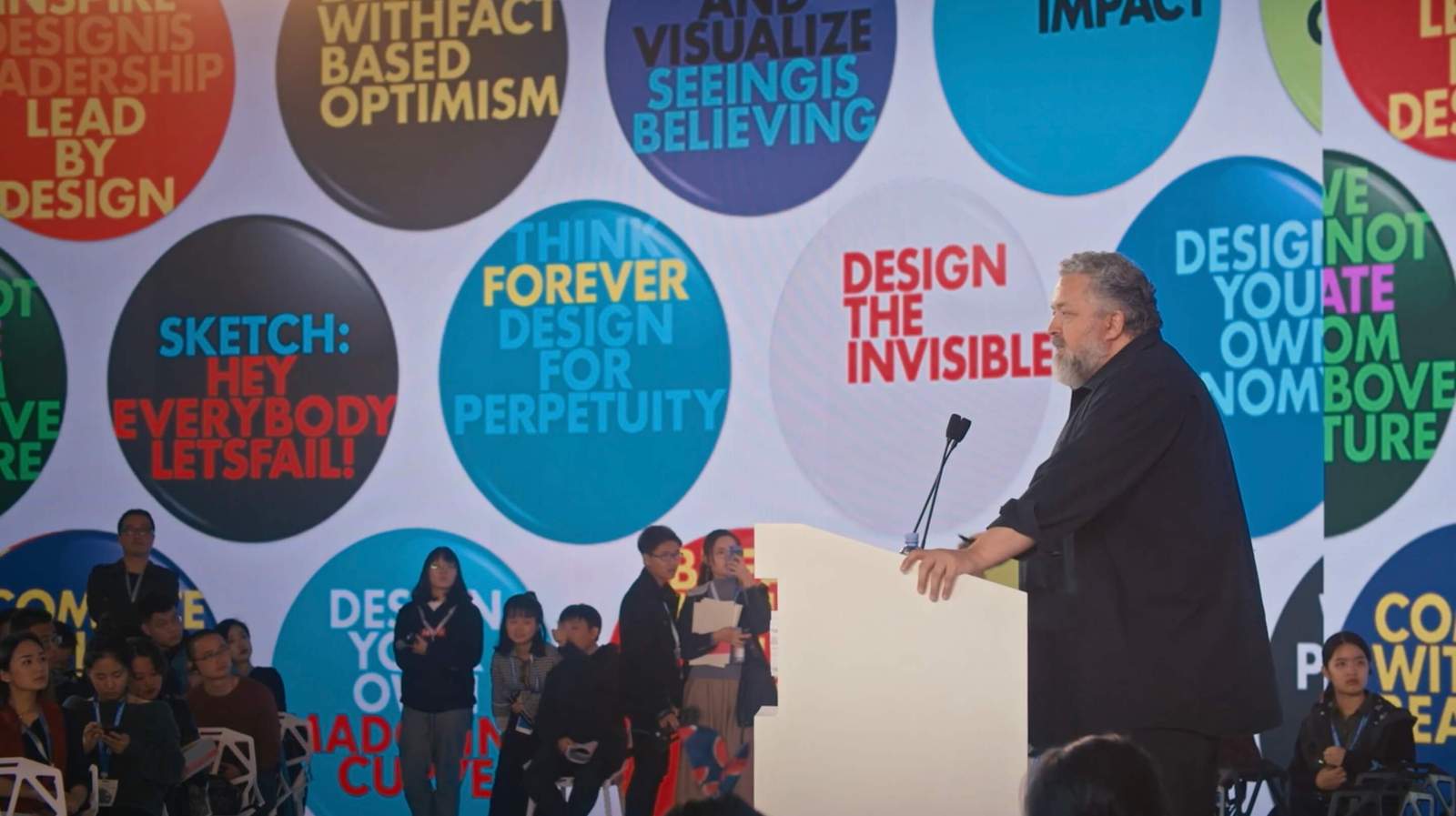On Friday the 13th under a nearly full moon during a buzzing tenth-anniversary edition of NYCxDESIGN, the city’s cognoscenti gathered for a packed screening at the Angelika Film Center on Houston Street. The cause for the hubbub (choreographed by PR firm Novità) was Mau, a new documentary about legendary designer Bruce Mau by Austrian filmmakers (and twin brothers) Benji and Jono Bergmann. Mau tells the story of the designer’s career, from his mining town upbringing in Sudbury, Canada, to a stint at Pentagram to his breakout role as Rem Koolhaas’s collaborator on S,M,L,XL, the landmark architecture book/brick published in 1995. Mau’s abilities landed him increasingly large-scale commissions: branding work for Coca-Cola, a redesign of the processional experience within the holy city of Mecca, and a reimagination of the entire country of Guatemala under the slogan of ¡GuateAmala! (The last two items weren’t realized.) Such vision powered his Massive Change exhibition—installed in Vancouver, Toronto, and Chicago—and led to the founding, with wife Aiyemobisi “Bisi” Williams, of the Massive Change Network, to which Mau devotes his full attention. (The Toronto design office that bears his name remains active.)
Bjarke Ingels, who appears in the film, moderated the Q&A after the screening. Earlier, he dropped by the pre-event reception at the nearby Poltrona Frau showroom; dressed in a space-age metallic gold jacket, Ingels greeted Mau, clad in all black, save for his shiny teal shoes. The phones, including Mau’s, came out for selfies and snaps. Mau may have been the star of the night, but Ingels was its starchitect.
Organized around Mau’s 24 Principles for Designing Massive Change, the film showcases his superhero ambition. It’s clear Mau is a driven individual who puts his heart and soul into every project he takes on. No longer satisfied with change alone, he is urgently working to create Massive Action. Today, Mau seems uninterested in design as a service industry but instead seems committed to design as a means of communication that can transform society at large.
During the Q&A, Ingels spoke about Mau’s influence on him, explaining that S,M,L,XL came out during his first year in architecture school. He joked that in its early years, BIG “stole a ton of shit” from Mau’s office, including a Christmas party PowerPoint presentation and the use of movable pinup boards. “[The boards] tend to make the studio look a lot more messy, but it also means that you can be constantly surrounded by all of the [office’s] current knowledge. It’s always there as evidence, and it attracts conversation and criticism and other spontaneous insights,” Ingels said. Perhaps more substantively, his Masterplanet scheme to redesign the earth seems, on some level, to be indebted to Mau’s Massive Change project.
Mau is the first film the Bergmann brothers have made together, and they too were influenced by their subject. One of Mau’s principles is, “Think Like You Are Lost in the Forest”; the brothers cited it as a creative provocation that they still use today. Benji even quoted Mau’s philosophical definition of the work of designers: “Design is the controlled release of information over time.”

Despite his stature as a visionary, Mau has also contradicted his rich insights. Early on in his career, he received an invitation to redesign MoMA’s graphic identity, but turned it down, saying that nothing could be better than the iconic word mark set in Franklin Gothic. Reflecting on that decision at the event, Mau said that his “preference is to do nothing. If I can get away with it, that would be my advice—it’s usually not possible, but that would be my preference.”
The conversation eventually turned to design as a systematic enterprise. This is problematic for Mau because “we invented this idea that if we can’t resolve it in our system, we’re going to put it outside of the system, and we’re going to call it an externality.” His example was the exhaust from your car; it’s an externality because someone else deals with its consequences. This no longer works, Mau said. “We very intentionally designed it that way, and it allows us to do absolutely horrendous things in the world. You can’t say, ‘It’s not my problem, it’s your problem.’ It’s our problem.” For Mau, what’s needed isn’t change, but action.
Energized, the crowd spilled out onto Houston Street. Some landed at an after-party in a Soho penthouse, whose two glass folding doors were thrown open to a private terrace overlooking cobblestone streets with a view of Lower Manhattan, a pleasant panorama to contemplate while absorbing the dim sum spread and open bar. The moment felt like a return to normal after two-plus years of pandemic precautions, though muddled by the world-altering crises addressed by the evening’s subject matter.
Deep into the merriment, Kyle Bergman, founder and director of the Architecture & Design Film Festival, rallied the revelers around Mau to solicit additional words of wisdom. Earlier, Mau had revealed that part of his current work includes the task of redesigning democracy. Braced against a marble tabletop and illuminated by tea lights, he recounted the clear threats posed by the rise of conservatism worldwide and the need to respond with antifascist efforts to reach those who have become disillusioned. Design, in the service of good politics, could help tilt the balance away from uglier contemporary forces. For a moment, the clouds parted, and the enormousness of the challenge—nothing less than the Fate of the World—stood before us. At least, until the speech ended and party talk resumed.


